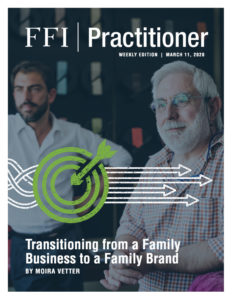
View this edition in our enhanced digital edition format with supporting visual insight and information.
Many family enterprises develop strong branding around their visionary founders. But what happens to this brand when the next generation assumes leadership? Thank you to this week’s contributor, Moira Vetter, for this article exploring how a family enterprise should build the power of its brand in conjunction with succession planning.
One of the greatest challenges any business experiences in transforming from a profitable small business to a legacy enterprise is navigating the waters of succession. An effective succession plan requires more than just moving names around on an org chart or a legal charter. To invest in its future, a family enterprise must build the power of its brand.
For a family brand to sustainably evolve and operate beyond its founder—or founding generation—it is essential for the decision-makers to engage in design thinking. Advisors and expert marketers often support family enterprises in this work, which includes:
- Aligning around core values – The core business values must be more than family values; they must be centered around the motivators of the future stakeholders and shareholders.
- Supporting and branding the next generation leadership – To take a brand forward, the new generation must emerge as current and future innovators.
- Thinking bigger and longer-term than ever before – To successfully shift from father to son, or aunt to niece, the brand and business plan must look beyond the current generation. Otherwise, the business can back itself into the same legacy challenge it is currently working to solve.
- Building a true brand platform – Creating or updating a brand is more than simply renaming a business or product, or updating a logo or website. A brand platform isn’t an aesthetic exercise; it is about strategic positioning for the future.
Core Values
Many companies develop a set of core values to inform the beliefs and actions of their employees. Those that ingrain these fundamental values in their brand personality and voice do more to demonstrate how the values create a true purpose and impact the lives of customers.
This isn’t a difficult exercise, but it takes discipline to ensure that instinctual ways of being are articulated in an outward-facing reality. True brands exist when customers feel, experience, and share the brand’s values. And it is in this work, and in these expressions and shared experiences, that a true brand comes to life.
For more on how core values can guide and inform growth, global consulting firm PwC developed a white paper on fostering family values in a business1. The paper addresses the three cultural dimensions of building, binding, and managing values.
Promoting the Next Generation
When a family business is intimately tied to its founder, it’s difficult to forge a path for the next generation. Many brands that overinvested in the personal brand of a visionary founder struggle to find a hook or story for the next leader.
The hook isn’t, and shouldn’t be, a gimmick. Just as the founder had a point of vision or innovation, so too must the next generation of leadership. In making a pivot that builds up the brand platform, new leaders must anchor themselves to the core values when framing that vision.
It is essential that the family inheriting the business do so not just from a place of “continuing operations” but from a place of “continued leadership.”
The hard truth that people often don’t want to admit is that the second and third generations may lack some of the vision the founder had. Advisors, consultants, and “adopted family”—those who have led shoulder to shoulder with the family business leadership—come in. The leadership must use those who know the business, recognize what makes it special, and understand or learn personal passions to help form a picture for the road ahead.
Thinking Big & Long
When it comes time for the next generation to take the reins, there are operational considerations that can distract an organization from long-term thinking. New leadership should engage in an honest evaluation of their passions and how these passions align with the core or future business.
A great example of this is Dr. Bonner’s soap company. Hatch2 wrote a story about the “peculiar history” of the company, founded by Dr. Emmanuel Bronner in 1948. And while the company may have nothing on the history of eccentric founders, it took the blood and sweat of sons Ralph and Jim, who took over in the 1990s, to save it from near demise. Since then, the brand has leaned into its vision of conscious consumerism to grow from $4 million in revenue in 1997 to over $100 million today3.
But saving a legacy business only works when the next generation is committed to a future that intermingles their passions. It is here, with Dr. Bonner’s third generation under the leadership of grandsons Michael and David, that the company took on a new vision. This placed Dr. Bronner’s on a bigger map and challenged their entire industry to reach future greatness through product innovation, a commitment to organic regenerative agriculture, fair trade, animal welfare, a focus on employer best practices, and a continued commitment to bold storytelling.
Tangible and Intangible Value of a Brand Platform
One of the fundamental, and, if not done carefully, surface exercises that family brands do is to update their identity—logo, website, business cards, and collateral. But an impactful brand encompasses much more than its visual identity. The brand platform extends to physical plants and offices, communications channels, recruitment efforts for employees and leaders, and could include philanthropic or foundation activities.
Often the original brand is deemed old fashioned, outdated, and out of touch with new consumers. While that is often the case, a strategic and intentional brand platform should uncover legacy qualities, ideas, and inspirations to serve as a foundation in re-imagining the new brand.
It is painful and costly to rebrand. That doesn’t mean it shouldn’t ever be done, but it’s imperative to do it right. If the exercise is considered with enough forethought and done with the help of branding experts that understand and respect both the past and future generations, a family enterprise can develop a core brand to live for generations to come.
To ensure success, the brand platform should be built not only around the family, but around the value an enterprise uniquely delivers to its customers. Yes, there was a time that people jumped through hoops for Sam Walton, but today it is undeniable that the Walmart brand has influence and equity far beyond the goods and services on its shelves or its tangible supply chain.
An entrepreneurial family started something that is now a bigger idea anchored to a long-term purpose. The brand that emerges is about more than legacy—it must represent a vision for a growing market with an expanding customer base. Well-developed brands, anchored in positioning strategy, bring those intangible assets4 into the equation for business valuation. Whether or not the family intends to exit or divest of the company, valuation is critical to the company’s ability to recapitalize to help pay back the family and reinvest for the future.
A strong brand has a value all its own. There are now accountants who specialize in calculating the equity of a brand separately from the actual balance sheet and operation. It is this intangible brand mystique that proves to the world, to future investors and to the next generation of leadership that something special was created that pays long-term dividends.
None of this is easy, but neither is running a family business. Those that invest in brands understand that this exercise is about more than running a business. A strong brand is the best investment in growing and expanding the firm’s legacy to support future generations.
References
1 https://www.pwc.com/gx/en/services/family-business/fostering-family-values.html
2 http://www.hatch-mag.com/2017/06/08/the-peculiar-history-behind-dr-bronners-magic-soap/
3 https://qz.com/quartzy/1374780/dr-bronners-soap-is-a-trendy-120-million-company/
4 https://www.thebalancesmb.com/how-to-calculate-your-brand-s-value-2295186
About the Contributor
 Moira Vetter founded Modo Modo Agency in 2007. Her firm helps raise visibility for companies as a strategic marketing partner, helping them position their thought leaders and tell their brand story in a way that breaks out and connects—internally and with new generations of customers. She has won the AMA Atlanta Agency Marketer of the Year award, the Atlanta Business Chronicle Women Who Mean Business award & an Enterprising Woman Entrepreneur of The Year award. She is a contributor to Forbes and Ad Age and serves on the boards of several professional associations and non-profit 48in48.
Moira Vetter founded Modo Modo Agency in 2007. Her firm helps raise visibility for companies as a strategic marketing partner, helping them position their thought leaders and tell their brand story in a way that breaks out and connects—internally and with new generations of customers. She has won the AMA Atlanta Agency Marketer of the Year award, the Atlanta Business Chronicle Women Who Mean Business award & an Enterprising Woman Entrepreneur of The Year award. She is a contributor to Forbes and Ad Age and serves on the boards of several professional associations and non-profit 48in48.

View this edition in our enhanced digital edition format with supporting visual insight and information.



